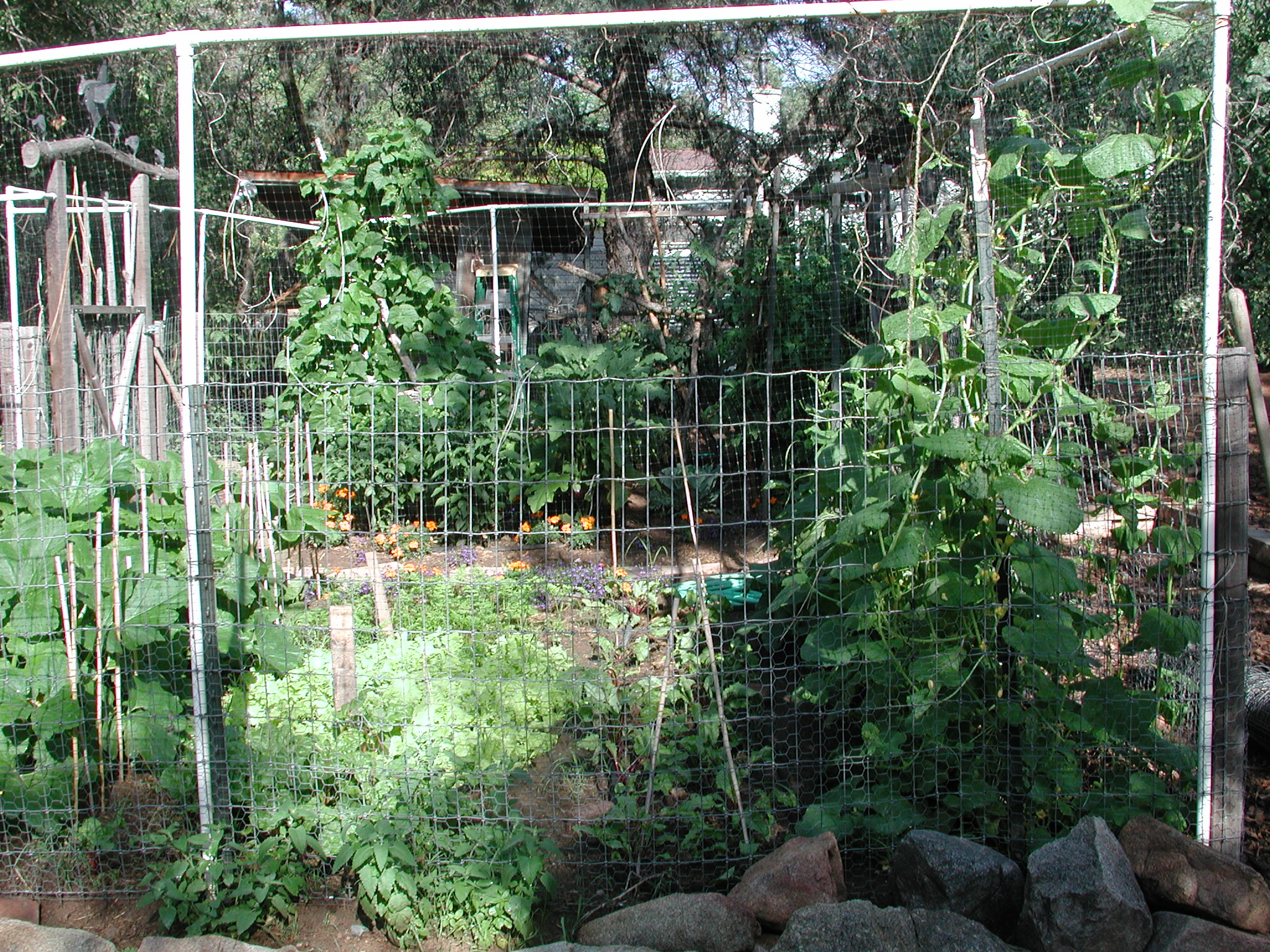 Fencing Your Garden - July 6, 2016 Jeff Schalau, Agent, Agriculture & Natural Resources University of Arizona Cooperative Extension, Yavapai County Garden fences are usually place to protect areas from animal trampling and herbivory (feeding on plants). Knowing the species of herbivorous wildlife present in your area is critical to building an effective barrier. Even so, if your garden is the only patch of green for miles, then hungry animals may find a way through the sturdiest, best-designed fences. Deer can be difficult to exclude with conventional fences and there are several “deer-proof” designs. Cottontail rabbits can be excluded with a two-foot tall poultry wire fence that is stretched tight to the ground and preferably buried at least two inches. Jackrabbit exclusion requires a three-foot tall fence buried at least six inches below ground. Javelina can be excluded using woven wire instead of (or combined with) poultry wire. Cattle and horses require a standard ranch-type fence that will withstand rubbing and pushing. Elk are perhaps the most difficult to exclude. Twelve-foot wire fences are often used, but aggressive bull elk can break through almost any wire fence. Woodrats and rock squirrels can climb and must be completely caged out where their populations are high. After reading this, you may decide to completely enclose vegetable growing areas – I know a few folks that have done this where wildlife pressure is extreme. If you go down this road, be sure to allow pollinators access (chain-link and/or poultry wire should work fine). Wood fences are usually more attractive than wire fences, but require some maintenance (i.e. paint, repair, etc.). Concrete block, brick, or stone are the most permanent types of fence but also the most expensive in terms of time and materials. Both wood and masonry fences can create privacy, but they also exclude light that would otherwise support plant growth. In addition, masonry fences retain and reradiate heat. This quality can be an advantage or disadvantage depending on your needs. In some situations, wood and masonry fences could trap cold air, which flows downslope on cold nights and may cause frost injury to fruit crops and tender ornamentals. Wire fences offer many functional amenities and can be modified to make them more attractive and/or less noticeable. Chain-link fences are very common. This is because they last a long time, require little maintenance, and are very functional. Gates are welded and all parts are weather resistant. Different colored vinyl coatings are also available to help the fence blend in to its surroundings. Woven wire is also a durable fencing material and is available in a variety of heights, patterns, and hole sizes to meet your functional and aesthetic needs. Welded wire is similar to woven wire, but is usually less durable. Both woven and welded wires are best suited to level ground because they are not flexible. Chain link is slightly more flexible for use on uneven terrain. Wire fences also allow air, water, and light to pass through. Wrought iron or welded metal fences are sturdy, but usually require some knowledge, equipment, or professional assistance. Size, location, and construction of a gate should also be considered. When large areas are fenced, you should consider putting multiple gates at allow access. The gate should be as sturdy as the fence and not restrict accessibility to equipment needed to work there. If fencing edible crops, the gate(s) should be able to exclude the herbivorous species discussed above. Many times, a combination of fencing materials will meet multiple pest exclusion goals. My larger yard is surrounded by a five foot tall chain-link fence which excludes javelina, contains our dogs, and keeps most predators away from our chickens. The garden is also fenced within the larger yard. This allows 360 degree access for chickens around the outside of the garden which provides a measure of grasshopper control. The garden fence is constructed of four foot tall woven wire with two feet of partially buried poultry wire attached with hog rings. Above this, I have bird netting supported by a PVC pipe frame to prevent our chickens from flying in. Creating this fence was an iterative process. My gate also has a poultry wire “door sweep” that prevents most rabbits from getting through the gaps. I have included a photo of my garden fence and other helpful fencing resources below. Happy fencing! Follow the Backyard Gardener on Twitter – use the link on the BYG website. If you have other gardening questions, call the Master Gardener help line in the Camp Verde office at 928-554-8992 or e-mail us at verdevalleymg@gmail.com and be sure to include your name, address and phone number. Find past Backyard Gardener columns or provide feedback at the Backyard Gardener web site: http://cals.arizona.edu/yavapai/anr/hort/byg/.  Basic garden fence constructed using four foot tall woven wire, wooden posts at the corners and T-posts in between. A two foot tall band of poultry wire was attached to exclude rabbits, and three to four feet of bird netting attached to a PVC frame to prevent chickens from flying over it.
Basic garden fence constructed using four foot tall woven wire, wooden posts at the corners and T-posts in between. A two foot tall band of poultry wire was attached to exclude rabbits, and three to four feet of bird netting attached to a PVC frame to prevent chickens from flying over it.Additional Resources Reduce Deer Damage in Your Yard Oregon State University Extension Service extension.oregonstate.edu/4hwildlifestewards/pdfs/deer.pdf Modifying Fences to Protect High-Value Pastures from Deer and Elk Montana State University Extension animalrange.montana.edu/documents/extension/modifiedfencesmg.pdf |